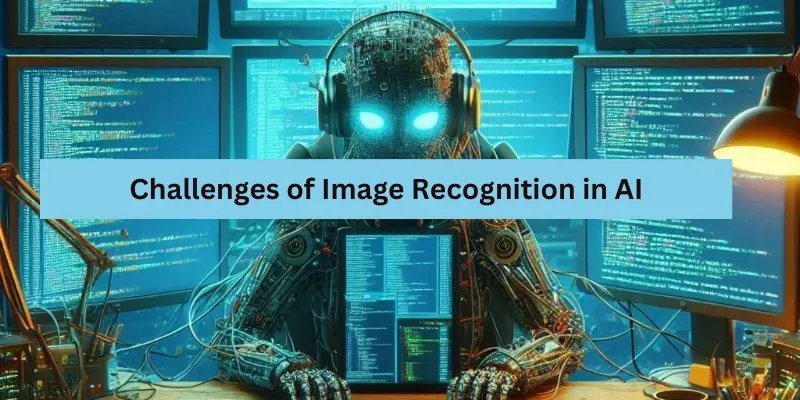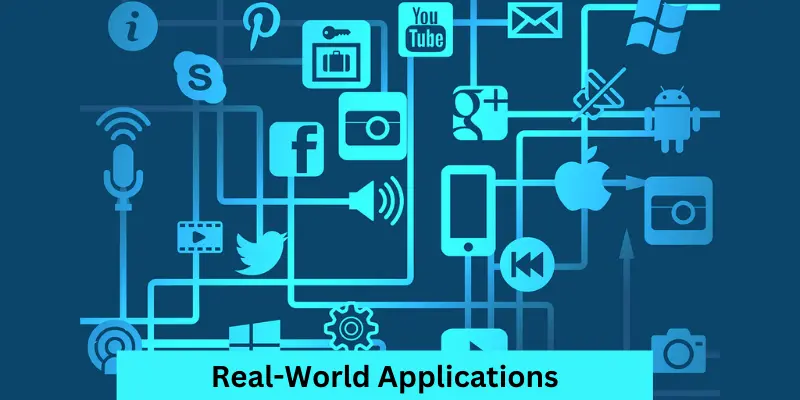Challenges of Image Recognition in AI: Obstacles & Solutions
Published: 01 Jan 2025
Image recognition is one of the most powerful applications of Artificial Intelligence (AI). From detecting faces in photos to enabling self-driving cars to see and understand their surroundings, image recognition is everywhere. But how does it work?
What makes AI capable of “seeing” the world like we do? In this article, we’ll explore the mechanics behind image recognition, how it’s used in the real world, and the technology that powers it. Challenges of Image Recognition in AI

What is Image Recognition in AI?
At its core, image recognition is a type of AI that allows machines to interpret and analyze visual data (such as photos, videos, or live camera feeds). The goal of image recognition is for a machine to identify objects, people, text, scenes, or activities within an image and make decisions based on this information. what is artificial intelligence
In simple terms, image recognition technology gives machines the ability to “see” and understand images the way humans do, helping them recognize and categorize various elements. Whether it’s identifying a person’s face, recognizing a specific object in an image, or analyzing a medical scan for signs of disease, image recognition is the technology behind all of these capabilities.
How Does Image Recognition Work?
Step 1: Collecting Data
The first step in image recognition involves data collection. Just like humans learn to recognize objects by seeing them over time, AI systems also require large amounts of data (images) to learn how to identify various objects.
For instance, in facial recognition, AI systems need thousands (or even millions) of images of faces from different angles, lighting conditions, and emotional expressions. This helps the system understand the variety and nuances of human faces. artificial intelligence
Step 2: Preprocessing and Labeling
Once the data is collected, it goes through a process called preprocessing. This step involves cleaning and organizing the data, ensuring it’s in the right format for AI systems to process. For example, images may be resized, and unnecessary background noise might be removed to make the data easier for the AI to handle.
Additionally, labeling plays a key role in the training process. For AI to learn what it’s looking at, human experts label the images. For example, if the AI is learning to recognize cats, humans will label thousands of images with the word “cat.” This labeled data is called a training dataset and is used to “teach” the system to make correct predictions.
Step 3: Feature Extraction
In this step, the AI begins analyzing the image itself. Feature extraction refers to identifying key parts of the image that are important for recognition. For example, in a picture of a cat, the system might focus on identifying features like the shape of the ears, eyes, fur, or whiskers.
The goal of feature extraction is to break down an image into smaller, more manageable parts that the AI can use to recognize patterns. The machine doesn’t see the image as a whole, but instead breaks it down into these small features and tries to find similarities with images it has already been trained on.
Step 4: Training the Model
Once the image features have been extracted, the system uses machine learning algorithms to train the model. Machine learning allows the AI to improve over time by learning from the data it processes.
Supervised learning is the most common method used for training image recognition systems. In supervised learning, the AI model is trained on labeled data. For example, if the task is recognizing different types of animals, the system will be trained on thousands of labeled images of cats, dogs, birds, and more. The system “learns” to associate specific features with particular labels.
Deep learning is a subset of machine learning that uses neural networks with many layers to simulate how the human brain works. Challenges of Image Recognition in AI: Deep learning allows AI systems to learn from large amounts of data more effectively and make highly accurate predictions. In image recognition, deep learning models use layers of neurons to process and identify patterns in images.
Step 5: Making Predictions
Once the model has been trained, it’s time for the AI to make predictions. When the AI is given a new image, it will analyze the features, compare them to what it learned during the training phase, and classify the image.
For instance, if the AI has been trained to recognize animals, it will take a new image, break it down into its features (e.g., fur texture, shape of ears, etc.), and make a prediction about what it sees. If it recognizes the features of a dog, it might label the image as a “dog.”
Step 6: Continuous Learning
AI is always improving. As it’s exposed to more data, it continuously learns from its mistakes and updates its knowledge. This is called model retraining, and it ensures that the AI remains accurate and relevant over time. The more data the system gets, the better it gets at making predictions.
Real-World Applications of Image Recognition

Healthcare
In healthcare, image recognition is used to analyze medical images, such as X-rays, MRIs, and CT scans, to identify patterns that could indicate disease or abnormalities. For example, AI systems can detect early signs of cancer, tumors, or fractures, often with greater accuracy than human doctors. Challenges of Image Recognition in AI:
Autonomous Vehicles
Self-driving cars use image recognition to “see” the world around them. AI systems in autonomous vehicles analyze data from cameras and sensors to identify objects such as pedestrians, other vehicles, traffic signs, and road markings. This allows the car to navigate safely without human intervention.
Facial Recognition
Facial recognition is one of the most well-known uses of image recognition technology. It’s used in security systems to identify individuals, unlock phones, or even track suspects in public spaces. AI models analyze the unique features of a person’s face, such as the distance between their eyes and the shape of their nose, to confirm their identity.
Retail and E-commerce
Retailers use image recognition to enhance the shopping experience. For instance, apps allow customers to take a picture of a product, and the app will identify the item and suggest similar products. AI is also used for inventory management, where systems can scan store shelves to check stock levels and identify misplaced items.
Social Media
Platforms like Facebook and Instagram use image recognition to automatically tag people in photos. By analyzing faces and comparing them to previously stored data, the system can identify who’s in a picture, saving users time and effort.
Agriculture
Farmers use image recognition to monitor crop health. AI systems can analyze aerial images from drones or satellites to identify potential issues, such as pest infestations or diseases. This allows farmers to address problems early, improving crop yields and reducing costs.
Challenges and Limitations of Image Recognition
While image recognition has come a long way, it still faces several challenges and limitations that can affect its accuracy, reliability, and widespread adoption. These issues arise from technical, ethical, and contextual factors, and addressing them is crucial for improving the performance of AI in this area. Let’s dive into some of the most significant challenges and limitations:
Bias in Data
Bias in data is one of the most significant challenges in image recognition. AI systems, including image recognition algorithms, learn from the data they’re trained on. If the training data is biased or unrepresentative, the AI may make inaccurate or unfair predictions. For example:
Facial recognition bias: Many facial recognition systems have been found to be less accurate at identifying people of color, particularly Black and Asian individuals, compared to white individuals. This is often due to an insufficient number of images of diverse ethnicities in the training datasets. As a result, the AI may fail to correctly identify faces or even misclassify individuals, which can have serious consequences in real-world applications such as security and law enforcement.
Gender bias: Image recognition systems may also exhibit gender bias, such as more accurate recognition of male faces compared to female faces, or vice versa. This can be particularly problematic when these systems are used for applications like hiring, surveillance, or identification.
Age and Disability bias: AI models can be biased against certain age groups or individuals with disabilities. For example, an AI system trained predominantly on images of younger adults may struggle to recognize older adults or individuals with specific disabilities, leading to incorrect predictions or outcomes.
Solution: To mitigate these biases, developers must ensure that the training datasets are diverse and inclusive. This means using images that reflect a broad spectrum of demographics, environments, lighting conditions, and contexts. Ethical AI practices and transparent auditing of data and algorithms are also crucial steps in addressing bias.
Quality of Data
The quality of data used for training image recognition systems is another critical challenge. Inaccurate, low-resolution, or poor-quality images can lead to poor recognition results. Key factors affecting data quality include:
Image resolution: If an image has low resolution, it may lack the detail needed for the AI to accurately interpret objects or features. For example, a blurry picture of a face may make it difficult for the AI to identify specific facial features like the eyes, nose, or mouth.
Noise in data: Background noise (unwanted or irrelevant information in an image) can also complicate image recognition. For example, cluttered backgrounds or distortions in an image can cause the AI to miss the main object of interest.
Lighting conditions: Variations in lighting, shadows, and contrast can also affect the AI’s ability to detect and recognize objects accurately. For example, an object might be easy to identify under optimal lighting, but the same object could be difficult to recognize in low light or when the lighting casts shadows on key features.
Unlabeled or mislabeled data: If the data used for training contains labels that are incorrect or inconsistent, the AI model may struggle to learn the right patterns. For instance, if images of dogs are incorrectly labeled as cats, the system will be trained to misclassify dogs as cats.
Solution: To ensure high-quality data, developers must curate datasets carefully, removing noisy or irrelevant images, ensuring high resolution, and managing lighting conditions during image capture. In addition, ensuring accurate labeling and consistent annotations is vital for training successful models.
Limited Context Understanding
One of the limitations of image recognition is that AI systems often lack contextual understanding. While an AI might be good at recognizing individual objects within an image, it often struggles to comprehend the broader context of a scene. Some examples include:
Contextual misinterpretation: An AI might recognize objects correctly in isolation but fail to understand how they relate to one another in a broader context. For example, an image of a plate of food might include a fork and a knife, but the AI might fail to identify the food itself or recognize it as a meal. This lack of context can cause misinterpretation of what the image represents.
Complex scenes: In complex scenes, such as crowded environments or images with multiple overlapping objects, an AI system might have difficulty identifying and categorizing all elements accurately. For example, an image showing a crowded street with many cars and pedestrians may confuse the AI system, resulting in incomplete or incorrect predictions.
Object occlusion: When an object is partially obscured by another object, the AI may have trouble recognizing it. For example, in an image where a car is partially blocked by a tree, the AI might fail to identify the car correctly.
- What is a primary cause of bias in AI image recognition systems?
A) Lack of computational power
B) Insufficient and unrepresentative training data
C) High-resolution images
D) Advanced algorithms - Which type of data is often problematic for image recognition systems?
A) High-quality, labeled data
B) Low-resolution, noisy, or poorly labeled data
C) Image data from sensors
D) Structured data like spreadsheets - How can image recognition systems misinterpret complex scenes?
A) By identifying too many objects correctly
B) By failing to detect only a few objects
C) By lacking the ability to understand relationships between objects
D) By not using enough data - Which of the following is an example of an adversarial attack on image recognition?
A) AI detecting a person’s face in a crowded room
B) Altering a road sign to make it unreadable to an autonomous vehicle
C) AI analyzing a low-quality image
D) Using facial recognition to identify people in a crowd - What is one solution to combat biases in AI image recognition systems?
A) Use data from only one demographic
B) Ensure training datasets are diverse and representative
C) Use high-quality images only
D) Limit the AI’s data collection - Why is real-time processing crucial for image recognition in autonomous vehicles?
A) To improve data quality
B) To ensure the vehicle can make quick decisions, like stopping for pedestrians
C) To reduce the complexity of the data
D) To avoid collecting unnecessary data - Which is a common challenge faced when performing image recognition on low-resolution images?
A) The data is too detailed for the system to process
B) The system may struggle to recognize key features or objects
C) The system becomes too fast
D) The system can recognize objects too easily - Which of the following describes the concept of ‘contextual misinterpretation’ in image recognition?
A) AI recognizing an object but failing to understand its relevance in a broader scene
B) AI recognizing an object in low light
C) AI misidentifying facial features
D) AI working only with high-resolution images - Which of these is NOT typically a limitation of AI in image recognition?
A) Lack of learning from past mistakes
B) Poor understanding of the context of an image
C) Inability to make real-time decisions
D) The use of advanced neural networks - What is a key ethical concern with facial recognition systems?
A) Inability to accurately identify faces in low light
B) Lack of computational power to process images
C) Unauthorized surveillance and privacy violations
D) Difficulty in training the system
Answer Key:
B) Insufficient and unrepresentative training data
B) Low-resolution, noisy, or poorly labeled data
C) By lacking the ability to understand relationships between objects
B) Altering a road sign to make it unreadable to an autonomous vehicle
B) Ensure training datasets are diverse and representative
B) To ensure the vehicle can make quick decisions, like stopping for pedestrians
B) The system may struggle to recognize key features or objects
A) AI recognizing an object but failing to understand its relevance in a broader scene
A) Lack of learning from past mistakes
C) Unauthorized surveillance and privacy violations
Conclusion:
Image recognition has revolutionized industries, enhancing everything from healthcare diagnostics to autonomous driving and retail experiences. However, as powerful as the technology is, it faces several challenges and limitations that must be addressed to fully unlock its potential.
The key obstacles, such as bias in datasets, issues with image quality, contextual misinterpretation, and adversarial attacks, highlight the need for ongoing research and development. By improving training datasets, using more advanced algorithms, and integrating continuous learning, we can mitigate these challenges. Additionally, ensuring that AI systems are transparent, ethical, and aligned with human values will be crucial as we continue to deploy image recognition technologies in sensitive areas like healthcare and security
AI image recognition faces several key challenges, including bias in training data, poor-quality images, difficulty in understanding context, and vulnerability to adversarial attacks. These issues can cause inaccurate predictions, misinterpretations, and ethical concerns. Overcoming these challenges requires improving dataset diversity, enhancing algorithm accuracy, and implementing robust security measures.
To improve AI image recognition, it’s essential to use high-quality, diverse, and representative training data. Implementing more advanced machine learning techniques, such as deep learning and neural networks, helps systems better recognize patterns and context. Additionally, continuous learning and real-time adjustments can ensure AI systems adapt to new data and real-world environments, enhancing their performance and reliability.
Proudly powered by WordPress






